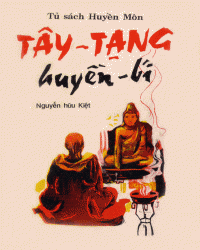In 1985, a boy named “Apo Gaga” was born into a nomadic family in eastern Tibet. In 1992 that boy was recognized as the Seventeenth Karmapa. His biography can nevertheless properly be said to start some eight centuries earlier.
The Innovation of the First Karmapa, Dusum Khyenpa
In 1189 C.E., at the age of 80, Düsum Khyenpa founded his main seat at Tsurphu, in the Tolung valley in central Tibet, the location of a river which feeds into the Brahmaputra. At that time, Düsum Khyenpa made predictions about his future rebirths, who were to become known by the title “Karmapa.”
Karmapa Pakshi was recognized as the first reincarnate lama, or tulku, in Tibet, after the First Karmapa left a letter predicting details of his reincarnation
Düsum Khyenpa chose Drogon Rechen, his main disciple, to hold and pass on to the next generation the wisdom lineage of the Kagyu (called the “Golden Rosary“) that had been transmitted to Düsum Khyenpa by his own teacher, Gampopa. But he also asked Drogon Rechen for something more: he presented Drogon Rechen with a prediction letter, detailing Düsum Khyenpa’s future incarnation. Drogon Rechen accomplished this task, passing on the lineage teachings and the letter of the Karmapa to is own student, Pomdrakpa.
In the early 1300’s C.E., Karma Pakshi (born 1204 C.E.), during a journey to Central Tibet for further education, encountered Pomdrakpa, who had received the full Kagyu transmission from Drogön Rechen, Düsum Khyenpa’s spiritual heir. Pomdrakpa realized, through certain very clear visions, that the child he met was the reincarnation of Düsum Khyenpa, as indicated in the letter given to Drogon Rechen. In this way, Karma Pakshi came to be known as the Second Karmapa, a reincarnation of the First Karmapa Düsum Khyenpa.
The Continuing Tradition of Lineage Transmission
Pomdrakpa conferred on the young Karma Pakshi all the teachings through traditional empowerments and formally passed on the lineage in full. Ever since this time, each young Karmapa, despite his pre-existing knowledge and accomplishment of the teachings, formally receives all the transmissions of the teachings from a lineage holder.
The Birth of the Tulku Tradition in Tibet
Dusum Khyenpa was the first to give such clear indications of the details of his next birth, so that a successor could be easily recognized. Karma Pakshi thus was able to suceed to the seat of his predecessor, Düsum Khyenpa, at Tsurphu Monastery. In this way, the most renowned Tibetan buddhist system of reincarnate lamas began from this very seat of the Karmapas. The institution of “tulkus” (the manifestation or reincarnate lamas) started by the Karmapa became one of the central institutions of Tibet. In this way, the unbroken lineage of the Karma Kagyu has been passed down through successive Karmapas up to and including the present one, His Holiness the Seventeenth Gyalwang Karmapa, Ogyen Trinley Dorje.
This institution of reincarnate lamas succeeding to their monastic and religious seats has continued in Tibet for over 800 years. Over the centuries, Tibetans have developed disciplines and safeguards to continue, protect and enhance this venerable institution. The Karmapas have continued their central role in this process of development. The 17th Karmapa seems destined also to play a central role in the transmission of this tradition into the new cultures outside Tibet which are learning about the tulku tradition for the first time.
Duyên Khởi và Vô Ngã Duyên khởi là giáo lý mà từ đó Thế Tôn giác ngộ Vô Thượng Bồ-đề. Từ đấy, Thế Tôn được Trời, Người tôn xưng với mười hiệu Như
Nếu tự ngộ được thì chẳng nhờ cầu bên ngoài. Nếu một mực chấp rằng cần phải có vị thiện tri thức kia mới được giải thoát thì không có lý như
Tác giả Yuval Noah Harari - nhà sử học người Israel và là giáo sư Khoa Lịch sử tại Đại học Hebrew Jerusalem, Đại học Tel Aviv...Hãy chỉ quan sátKhi còn ở tuổi thiếu niên,
Vì không có hiện tượng nàoLà không duyên sinhNên không có hiện tượng nào là khôngTrống rỗng sự tồn tại cố hữu (Tất cả các pháp là vô tự tính)- Căn Bản Trung
Con đường Bồ tát – con đường lý tưởng nổi tiếng của Phật giáo Đại thừa – không phải là pháp tu để thành thánh, thành tiên, mà là một lối sống
QUAN HỆ THẦY TRÒ Theo Tinh thần Kinh Kế thừa Chánh pháp Thầy, vầng mây bậc, thong dong, núi cao biển rộng Con, cánh nhạn chiều, chân trời sải cánh, dõi theo Thầy,
Giữ giới là lựa chọn tự do Giới luật của Phật giáo có nghĩa là: “Anh đừng tự làm thương tổn mình, anh đừng tự làm hại mình”. 1. Tự do của lệ thuộc
Đạo Phật là gì Lama Zopa and Lama Yeshe Khi bạn tìm hiểu về đạo Phật tức là bạn đang tìm hiểu về con người thật của mình, về bản chất của tâm trí
Vô minh bẩm sinh & Vô minh văn hóa(VHPG) Mọi kinh nghiệm của chúng ta, kể cả giấc mộng, khởi lên từ vô minh. Đây là một tuyên bố làm hoảng hốt

